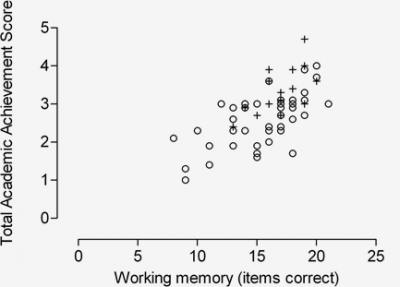Working memory definition
Working memory (WM) serves as the mind’s workspace, and the size of our WM – it’s capacity – is a key limiting factor in our ability to carry out a wide variety of cognitive tasks, including problem solving, decision-making, planning and comprehending – cognitive skills we associate with being smart.
Working memory is necessary for staying focused on a task, blocking out distractions, keeping you updated and aware of what is going on in this process, and applying relevant cognitive strategies to process the information. Working memory impairments result in loss of attentional focus – such as difficultly focusing on reading a text or attending to a conversation; or short term memory problems in day to day tasks.
Working memory can be defined in everyday language as the brain system that helps us keep information in mind while using that information to complete a task or execute a challenge:
a brain system that provides temporary storage and manipulation of the information necessary for such complex cognitive tasks as language comprehension, learning, and reasoning. (Baddeley, 2003, p. 189)
Alternatively it has been defined as:
a flexible, capacity limited, mental workspace used to store and process information in the service of on-going cognition” (Morrison & Chein, 2011, p. 233)
Working memory capacity
Since working memory makes information available for more advanced cognitive processing, working memory capacity – the number of distinct ‘chunks’ of information you can hold in mind at the same time – is one of the main rate limiting factors for higher-order cognitive functions such as fluid intelligence, planning, complex decision making, comprehension, and creative problem solving.
In general terms, the larger your working memory capacity or ‘mental workspace’, the greater your capacity for higher order cognition and thus academic and professional achievement. An example of this relationship is shown below.
Working memory brain regions
Working memory intensive tasks activate lateral pre-frontal cortex and parietal cortex – part of the so-called ‘fronto-parietal axis’.

Requirements for Working Memory Brain Training Games
Working memory capacity can be expanded through targeted brain training (Morrison & Chein, 2011; Klingberg, 2010; Verhaeghen, Cerella, & Basak,2004; Westerberg et al., 2007).
Working memory games that target core working memory mechanisms in the brain (rather than just skill in the training game itself) must be designed to:
-
limit the use of strategies that ‘cut corners’ in the working memory game itself
-
minimize automatization (where the task becomes effortless due to practice)
-
include tasks/stimuli from different modalities such as audio AND visual
-
require doing a task in the face of interfering information
-
enforce rapid working memory encoding and retrieval demands
-
adapt to players’ changing levels of ability as they get more practiced
-
demand high cognitive workloads (i.e. hard cognitive tasks requiring intense focus).
The original Jaeggi et al dual n-back working memory exercise implements all these principles. i3 Mindware implements them more systematically and effectively with 2G+ brain training.
References
Baddeley, A. (2003). Working memory and language: an overview. ASHA 2002, 36(3), 189–208. doi:10.1016/S0021-9924(03)00019-4[space]
Jaeggi, S. M., Buschkuehl, M., Jonides, J., & Perrig, W. J. (2008). Improving fluid intelligence with training on working memory. Proceedings of the National Academy of Sciences, 105(19), 6829–6833. doi:10.1073/pnas.0801268105 [space]
Klingberg, T. (2010). Training and plasticity of working memory. Trends in Cognitive Sciences, 14(7), 317–324.[space]
Morrison, A., & Chein, J. (2011). Does working memory training work? The promise and challenges of enhancing cognition by training working memory. Psychonomic Bulletin & Review, 18(1), 46–60. doi:10.3758/s13423-010-0034-0[space]
Verhaeghen, P., Cerella, J., & Basak, C. (2004). A Working Memory Workout: How to Expand the Focus of Serial Attention From One to Four Items in 10 Hours or Less. Journal of Experimental Psychology: Learning, Memory, and Cognition, 30(6), 1322–1337. doi:10.1037/0278-7393.30.6.1322


